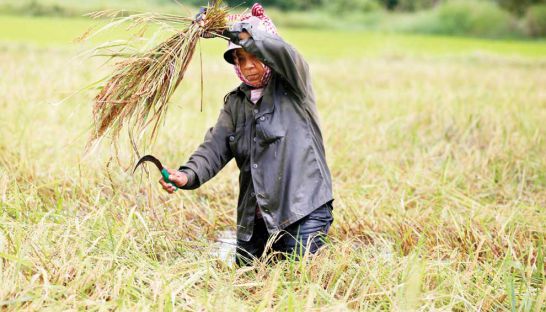Rice exports show slow growth
Rice exports show slow growth
Cambodian rice exports declined dramatically in March, causing the average export growth of the Kingdom’s dominant cash crop to increase by only 3 percent during the first quarter of this year, nearly wiping out the double-digit growth seen in January and February.

According to rice export data released by the Ministry of Agriculture yesterday, Cambodia exported a total of 166,678 tonnes in the first quarter this year, up from 162,220 tonnes during the same period last year. While growth in January and February accelerated greatly by 11 percent and 17 percent respectively, the weighted average was bogged down by a 16 percent year-on-year decline for March exports.
Hun Lak, vice president of the Cambodia Rice Federation (CRF), said yesterday that the March declines can be attributed to stricter sanitary and phytosanitary (SPS) standards being imposed on shipments to China, Cambodia’s second largest market after the European Union.
He added that only 26 Cambodian millers have been granted official approval to export to China with another 55 waiting to be vetted by China’s General Administration of Quality Supervision, Inspection and Quarantine.
“A large amount of the millers that used to export to China in the past are no longer able to export there now,” he said. “If the issue over SPS standards cannot be resolved soon, our export figures will continue to decline and this year will not be good.”
According to Lak, despite CRF lobbying Cambodian authorities to fast-track negotiations with China to allow increased market access, the body has yet to produce tangible results for its members.
CRF has previously warned that the Cambodian rice industry could soon collapse millers diversify and tap into increasingly narrow and strict global markets.
In addition to the hurdles of entering the Chinese market, Cambodian millers are also concerned about the EU’s call to eradicate the use of the fungicide Tricyclazole in rice production. The EU has given farmers until June to meet the revised threshold levels on white rice – 0.01 milligrams of Tricyclazole residue per kilo of rice and December for fragrant rice.
In the first quarter of this year, Cambodia exported 84,059 tonnes of rice to the EU while exports to China accounted for nearly 40 percent of total exports at 67,482 tonnes.
Song Saran, CEO of Amru Rice, one of the country’s biggest exporters, raised similar concerns about Chinese market access but noted that the Ministry of Commerce (MoC) preemptively submitted a list of only 18 millers, instead of the allotted 26, to China for the current harvest season.
He added that while Amru used to export 7,000 to 8,000 tonnes of rice to China annually in the past, it has yet to be included by the MoC for Chinese clearance.
“Now, we are trying to get into the Chinese market to accelerate our rice exports,” he said, adding that reliance on the EU market had reached a saturation point at about 300,000 tonnes exported annually.
“First, we need to send the full list of all 26 companies that have satisfied China’s SPS standards to them so that they will accept our exports,” Saran said.
“Second, we need to negotiate with China to allow more companies to export like they were before.”
Yang Saing Komar, founder of agricultural organisation CEDAC, said that new market access was the main challenge for the sector after it had been devastated last year by a prolonged drought.
“The weather is better than last year as there is a lot more rain which will provide higher yields of rice paddy to be milled,” he said.
“Paddy production is not the problem to boost exports. The high cost of processing, increased regional competition and greater market access continue to be the industry’s main challenges.”














